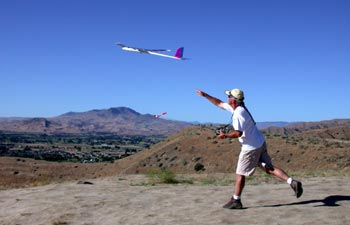What is Slope Flying?
Slope soaring offers a unique brand of flying excitement not found in other types of RC model flying. From flying lazily along with a floater, to breath taking high speed beach runs, slope racing, and aerobatics, there is something for every skill level of pilot. Besides being a lot of fun, how many other model pilots do you know who want the wind to blow?
It is easy to see why slope soaring is fast becoming one of the most popular parts of RC soaring. Slope soaring is no longer limited to just the east and west coasts. As the popularity of slope soaring grows, more flying sites are turning up throughout the country.
 |
| Mike Goldston launches an Omega at a slope near Star, ID Photo: Greg Smith |
Finding A Hill
Wherever you can find a respectable-sized hill with a 10-20 m.p.h. wind blowing straight into the slope, you can slope soar. The wind is deflected upward by the slope of the hill creating the lift we soar on. The amount of lift generated by a particular hill is regulated by the wind velocity and the amount of slope in the hill. Also a hill that has a smooth approach to it (free of trees, buildings and etc.) will almost always produce stronger lift. Don’t overlook places like dams, reservoirs, bluffs overlooking lakes and river valleys. They all make good flying sites. The ideal slope site is one in which there is a “bowl” created by either a curved hill or by a series of hills.
Flying Tips for Novice Soarers
Launch the Model into the wind out over the crest of the hill by throwing it with the wings level and nose pointed slightly down. Let the model travel up a little ways to build up speed and then make a turn that brings the flight path of the model parallel to the slope. When you need to turn the model around, make your turn into the wind away from the slope and again fly parallel to the slope. Repeat the above procedure when it is time to turn again. Flying this flattened figure eight course back and forth across the face of the slope is standard procedure. This helps keep the model in the maximum lift zone which yields the most altitude gain.
{pgomakase}Landing
To make a landing approach, start with a fair amount of altitude, then fly the model slightly behind the crest of the slope, and try to fly a steady descending path right down to a landing on top of the hill. If you are too high on your landing approach, make S-turns to lose altitude or go around and try it again. Most slope soaring sites create an air turbulence on the back side of the hill. Avoid getting caught in this turbulence as it might cause you to lose control of your model and crash.
Ballast
Depending on the model, when flying in winds of excess of 20 m.p.h. some ballast may be needed. Stick-on lead weights are ideal for adding ballast. Simply press them in place inside the fuselage directly over the C.G.
Aerobatics
Slope soarers don’t have engines to pull them through acrobatic maneuvers like power models do, so we have to rely on the lift and the speed of the model to perform aerobatics. Always pick up speed by diving the model before entering a maneuver. The amount of speed required, depends on the maneuver and the available lift. If you are new to slope soaring make your maneuvers into the wind at first until you feel comfortable.
Note: When flying at established sites, check with the local flyers to determine what is the best approach for landing at this site.
It will take a little practice to master the art of slope soaring, but it is well worth the effort and a lot of fun. So, next time the wind blows, grab your model and head for your favorite slope.
Reprinted with permission from Sig Manufacturing Co., Inc.


Anyone know of a slope flyer simulator for MAC OSX.